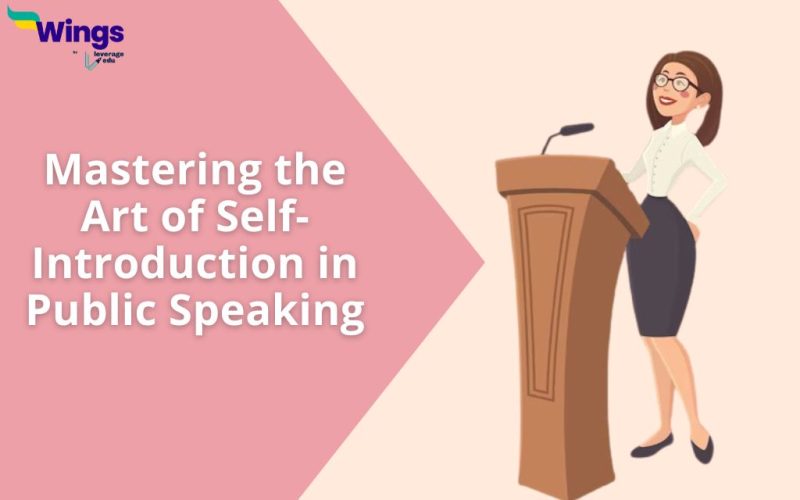Whenever you meet someone for the first time, you are required to give a self-introduction. Sometimes, that someone can be an individual person or a group of people or an audience to whom you are presenting yourself. To create a good impression, it’s very important that you understand the principles of how to give a self-introduction in public speaking. In this article, we will be talking about some of the most important principles of self-introduction in public speaking.
This Blog Includes:
Most Popular Tips for Self-Introduction in Public Speaking
Speaking in public or to a group of people can be a good opportunity to create a friendly environment for yourself. While meeting new people, you are required to give a self-introduction speech, where you are highlighting details like who you are, what you do, what interests you how you plan to achieve your goals, etc. You need to give a self-introduction which results in a positive manner not only to you but to the audience or people around you. Here is a list of some of the most popular tips for self-introduction in public speaking.
Also read – How to Prepare for an Interview?
Grab Attention With An Opening Hook
To grab the attention of your audience, it’s very important to start your self-introduction in public speaking with a convincing and compelling statement. You can also start with thought-provoking questions or an interesting story or anecdote to make the audience think that you are about to put on an interesting show.
Check the following example –
Hello ladies and gentlemen, I am absolutely thrilled to be standing before you today, filled with an overwhelming sense of enthusiasm and passion. As I introduce myself, let me assure you that my words will be infused with the utmost excitement and genuine fervour. My name is [Your Name], and I am honoured to stand before you today. As a [your occupation or role], I have had the privilege of [highlight your work experience or expertise].
Highlight Your Background and Expertise
Your education and professional background will reflect your personality. So it’s important to mention what you do for a living. Share a concise overview of your relevant experience, qualifications, or achievements that establish your credibility and make you an authority on the subject matter.
Mention the names of schools and institutions you’ve been a part of and what skills have you acquired while pursuing your education. It would be great if you mention any past experiences where you brought your expertise to use.
Connect With The Audience
People often listen to others who share common interests and knowledge with them. Finding common ground can be a good way to establish a connection with your audience in a good way You can do this by sharing a relatable personal experience or expressing your understanding of their needs, interests, or challenges.
What you can do is talk about some creative ideas and projects and even mention storytelling or narrative development.
Be Enthusiastic & Passionate
Try to communicate with your audience in an enthusiastic and passionate way about the subjects or topics you are addressing. You can make your introduction more memorable by delivering energetic and genuine highlights about yourself. It’s important to be enthusiastic and passionate while giving your self-introduction.
For example –
The energy that courses through me when I delve into [Your Field] is unparalleled. It’s a world where creativity meets innovation, where possibilities are limitless, and where I find inspiration to push boundaries and challenge the status quo.
Use Appropriate Body Language & Eye Contact
Using appropriate body language and establishing eye contact whenever you appear before an audience is crucial to create a sense of connection and engaging them on a personal level. People who use proper body language and hand gestures are considered trustworthy and responsible.
Conclude With A Call To Action (CTA)
The conclusion of your self-introduction needs to emphasise a clear call to action. A call to action will encore your audience to take a specific action or step, such as asking relevant questions, engaging more in conversation, participating in future events, etc.
For Example – ‘Moving towards the conclusion of my self-introduction, I want to leave you with a powerful call to action. Whatever enthusiasms and passions you have planned for yourself, I want to encourage each and every one of you to feel ignited towards them. Whatever I’ve said here today must be used as a positive step towards achieving your goals.’
Also read – Introducing Yourself in an Interview: Key Points
Self-Introduction in Public Speaking Sample
To help candidates prepare for their self-introduction in public speaking, check the following sample.
‘Good Morning/ Afternoon/ Evening ladies and gentlemen, my name is Tom Arthur and I am glad to present myself before you today. As a High School Teacher, I have had the privilege of teaching some of the sharpest minds in this city and I have always guided my students to understand the importance of moral education in life. Today, I would like to [state the purpose or topic of your speech]. Throughout my presentation, I will [outline the main points you will discuss]. I am excited to share my knowledge and insights with you, and I hope that my words will inspire, inform, or entertain you. Please feel free to engage with me during the Q&A session or approach me afterwards to continue the conversation.
Thank you for your attention, and let’s begin our journey together.’
For more of such latest blogs on interview preparation, careers and more, stay tuned with us. And don’t forget to follow us on, Facebook, Instagram, Twitter and YouTube .
 One app for all your study abroad needs
One app for all your study abroad needs















 45,000+ students realised their study abroad dream with us. Take the first step today.
45,000+ students realised their study abroad dream with us. Take the first step today.
